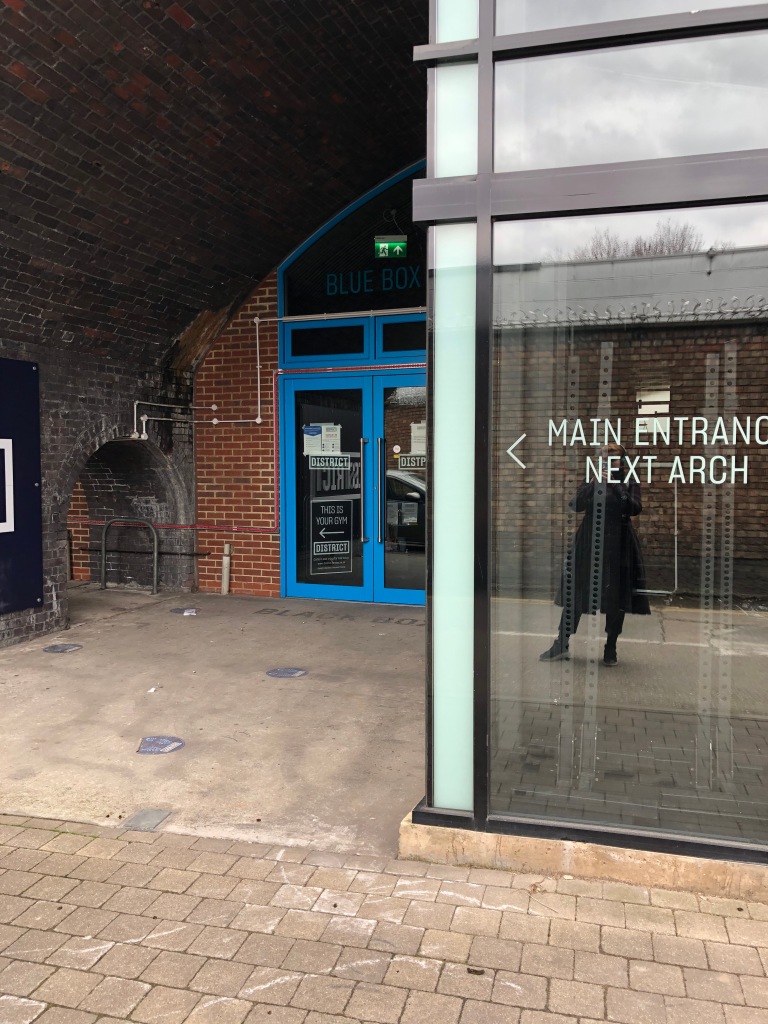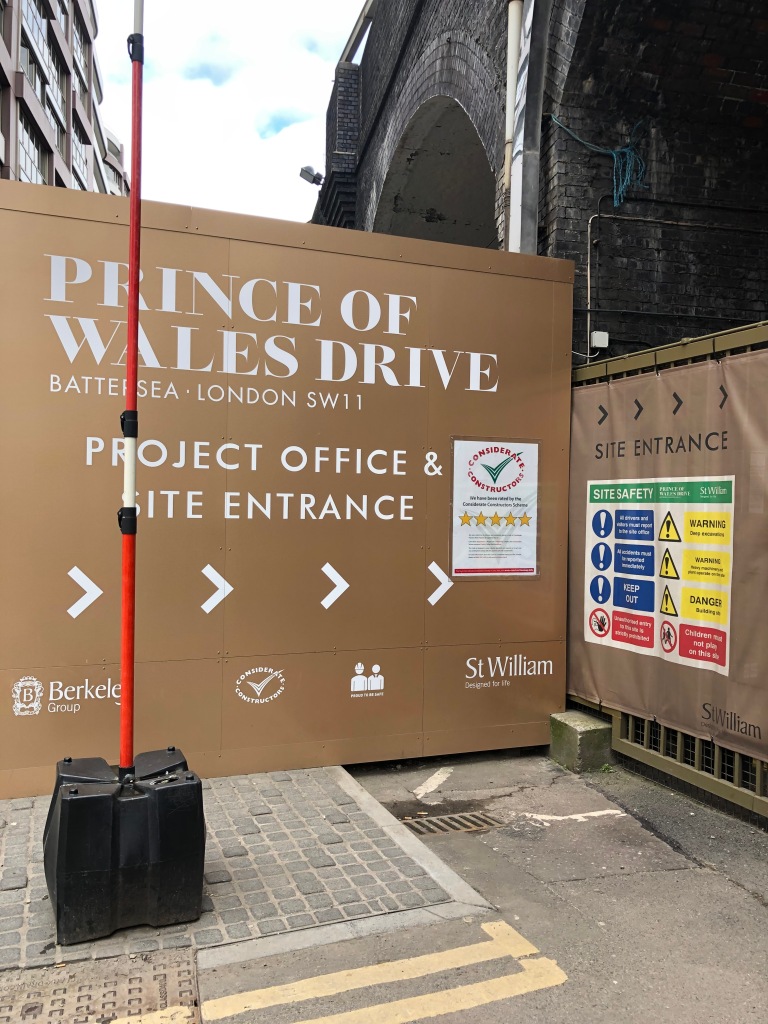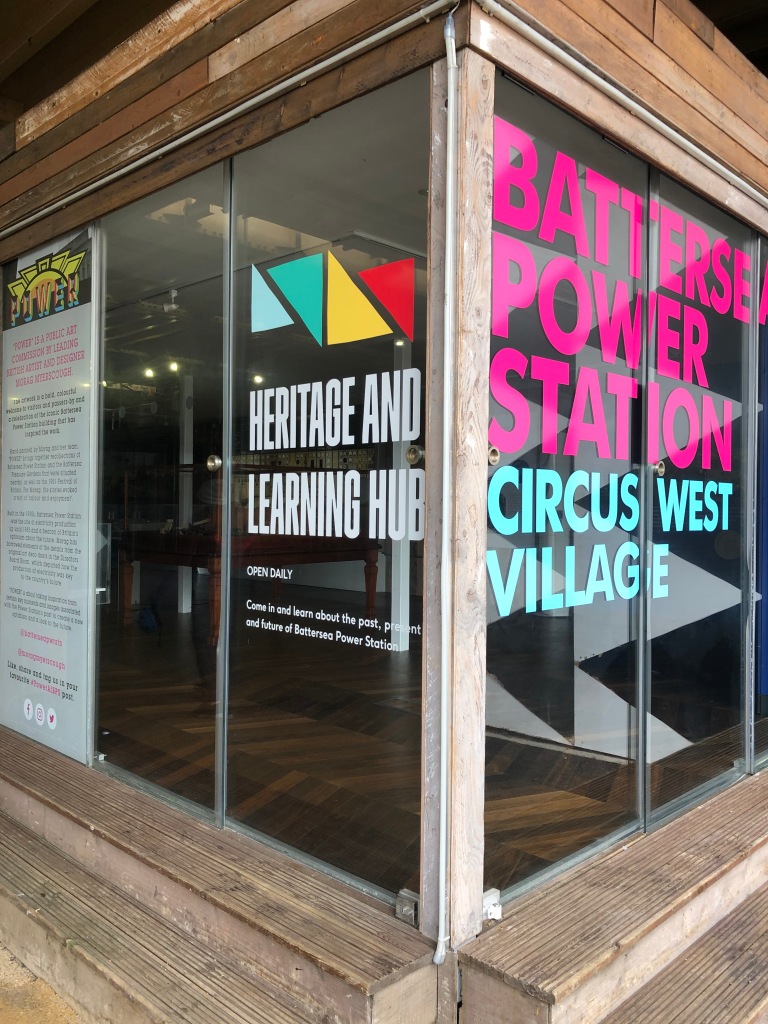So I’ve been doing a lot of wordy thinking, but I decided it was time to actually get out into the ‘field’ (well, London), and do some more hands-on research around my subject area.
I decided to follow a section of railway line near my house, and consider all non-rail-related uses and interactions with railway infrastructure in communities along the route, both realised and potential.

I initially created this sketch map, which shows all rail infastructure (in blue) within 2 miles of my house. I decided to focus on the section of railway line between Battersea Park Station and Victoria — I chose this route because I have travelled it many hundreds of times by train with barely a thought (having lived in Brighton for 10 years, I passed through it on every trip to London), but since living in this neighbourhood, have really enjoyed getting to know parts of it from down on ground level. Places once flown through with such fleeting glimpses have now become intimately aquainted friends during these long months of lockdown with travel limited to where my feet can carry me.
This map shows that section in tighter detail:

Although I’m calling it ‘Victoria to Battersea’ because it reads better from top to bottom/north to south, I actually walked the route from south to north, and then got a cheeky train home to enable me to fill in any gaps in my knowledge. So the journey actually starts here, outside Battersea Park Station:

The above image shows the railway bridge crossing Battersea Park Road, with the entrance to the station hidden underneath it on the left. More on the station later, but for now, we skip a hundred feet or so of the line as we follow Queenstown Road off to the left in front of Boqueria, where we shortly hit a big roundabout (which is overlooked by the actual platforms of the station).
I started off by doubling back on myself — at this roundabout, there is an entrance to a line of industrial units situated underneath the railway arches, which I decided to check out. Most of them were closed — a caterers, a sofa warehouse — but perhaps the most interesting of these was a ‘dark shop’…

I steal here, the now common parlance of ‘dark kitchen’, which refers to non-public-facing kitchens that exist purely to service customers of apps like Deliveroo and Uber Eats. Big chains like Wagamama have them, as well as smaller individual caterers — and indeed there is much more demand for these kinds of services post-lockdown… My landlord owns a swanky restaurant in The City, but for the last few months has been operating a ‘dark kitchen’ from a currently un-used pub in Battersea, selling (very nice) risottos. Railway arches can be a great spot for these kinds of facilities, which do not need to be situated on any main drag, and benefit from being slightly away from residential areas, due to the constant buzz of delivery motorbikes. Anyway, this is not that (though I know of some of these situated in railway arches on a different stretch of line near my house) — this is what I am terming a ‘dark grocery store’ — which exists purely for the service ‘Getir’ (I’d never heard of it!), who claim they can deliver you essential bits and bobs within 15 minutes. You can see here the fridges containing chilled items, and towards the back of the room were orderly shelves stacked with boxes of ambient goods. A suspicious man asked me if I was looking for anything, and I felt suitably chastised as to leave, but excited to have already found something new which I didn’t know about.
Back slightly closer to the roundabout was an open archway, which enabled me to cross through underneath the railway — another thing I didn’t know existed! This felt like such a striking and under-utilised space, it was fun to daydream about what could be hosted here…

Passing through, I found the back entrance to the Getir grocery store (along with some of their delivery bikes), as well as what looks like a stairway into the back of Battersea Park Station, Platform 1. (More on this later!)

Retreating back through the tunnel (as both ends of this section were closed off), I returned to the main roundabout, and crossed Prince of Wales Drive, pausing to admire ‘Microscopic Park Life’, the beautiful tiled art installation by Amalia Pica, installed in 2018.
I’ve appreciated this piece before, mostly because I really love tiling, and think this was a wonderful way of manifesting this super cool art project. As documented above, the artwork depicts various microscopic lifeforms found in nearby Battersea Park in a beautiful manner, spanning the entire underside of both sides of the railway bridge, by the road. This to me is a great example of place in the context of railway architecture. There are bus stops under this bridge, and this artwork transforms what would otherwise be a quite bleak, drab place to stand and wait into something artistic, educational, and interesting! Big love for this one.
I then followed the railway line on my right down Sopwith Way, passing a few more businesses situated in the arches, including a tile shop (appropriate), a beauty outlet, and two or three gyms, as well as a lot of closed (though seemingly in use), mystery units.
While I don’t really class these as ‘placemaking’, I am interested in the potential business uses of railway arches, and it occurs to me at this point that I could probably do an entire research project about ‘uses of railway arches in South London’, though it may be harder to formulate a question or a critique, it certainly would be interesting (to me) to see what these arches lend themselves to.
As we follow Sopwith Way, with the railway up high on our right, the arches and spaces underneath the railway become fenced off, as part of the Prince Of Wales Drive development. I don’t know a huge amount about this development, but I assume it is designed to connect in with the Battersea Park Development (which we’ll get to shortly), and follows the general theme of massive housing developments springing up in this part of South London (especially in Vauxhall). I hold limited enthusiam for these projects as they inevitably carry the ‘luxury’ tag, putting them well out of the reaches of the likes of (probably) you and (definitely) me.
However, in the context of placemaking and railway infrastructure, these projects can be worth looking at a bit closer, as they often focus on creating a sense of place and desirability at ground level, so I will be interested to see how they continue to develop this area, once (if!) common folk like me are allowed access (hoping this won’t be a gated development).
So, on down a long and decidedly dreary stretch of Sopwith Way, with little to highlight along the line, apart from a back entrance to Battersea Dogs and Cats Home (more on this later), and these rather interesting brickwork cubbyholes, which I find myself imagining as cute homes for art:


This section of road feels very much like somewhere you’re not meant to walk along, and I find it completely deserted, as I have done every previous time as well.
But we’re soon back to civilisation, as we hit the river, and one entrance to the Battersea Park Development.

This bold ‘POWER’ artwork looks like the work of Morag Myerscough (similar to that seen along the river in the South Bank Centre area), and what it’s attached to is the Grosvenor railway bridge running across the Thames. This bridge is for trains only, so we’ll be crossing via another means, but let’s stay with the railway line here for a while longer, and cross underneath this bridge.
For all its flaws (only for the hyper wealthy, zealously over-securitied etc), the Battersea Park development does offer some clean, accessible public toilets under here, as well as a relatively interesting (though small) heritage centre, documenting some of the history of Battersea Power Station, which the trains above us are currently flying past.
Also under the bridge is a barely shielded gym area, supposedly a Bear Grylls enterprise, in which people can often be seen vigorously wafting large ropes. Whatever floats your boat I guess. This does continue the theming I’ve already seen along the route of railway adjacent fitness spaces though.
I double back on myself again a bit here, in order to check out the other side of the railway — crossing under this bridge, I follow Arches Lane down the other side of the railway tracks. This area is stll under development, and is currently blocked off at its southernmost end, but presumably at some point will connect into the aforementioned Prince of Wales Drive development.
Much though I hate myself a little for buying into such gentrification, this short street is home to several very appealing prospects — a small theatre, an Arclight cinema, several nice food places (including delightful Tonkotsu Ramen), some more public toilets, (well done), and a crazy golf themed club/bar (I’m not gonna lie, it tempts me, against my better judgement).
This street is just part of the efforts to develop the land around Battersea Power Station from an abandoned industrial wasteland into a desirable place to live — important, given the eye-watering price tags of the new flats here. This is a smart use of the immoveable, unchangeable railway infastructure to create some cool spaces which are hopefully very much fit-for-purpose (all of these spaces will benefit from being able to create lots of noise un-complained about, though I do wonder how the theatre will cope with the overhead rumble of trains…)
I turn back around now, and, mildly grumpy at the lack of pedestrian crossing over Grosvenor Railway Bridge, I turn left, and cross nearby Chelsea Bridge, immediately turning right on the other side to rejoin the railway. This side of the bridge couldn’t be more different to the gentrified, art-plastered underside of the other bank — here, a busy main road rushes underneath the train lines, and on the side closest to the river, a large void space underneath the bridge has unimaginatively been fenced off. I presume this was to prevent rough sleepers (I have previously seen evidence of small encampments here and nearby), but it feels like a very unimaginative and uncharitable use of the space. Admittedly, the dark underside of a bridge next to busy traffic may have limited uses, but its current incarnation still feels disappointing.

I turn back here, deciding to keep the railway on my right still. The eastern side of the railway here is given over to a large train storage shed, and although there is some interesting stuff on that side, for the purposes of this walk I am following the line from Battersea Park station to Victoria, and that line runs on the western side.
So, on I go, wending my way through the maze-like modern housing development behind the Lister Hospital. It is hard to keep close to the railway line for some of this, but I double back a few times and loop round the tower blocks to try and see as much as possible. In truth there’s mostly little to report, though I do see a cat!

As a child, flying past these blocks, I always dreamed of one day living in flats like this. In the heart of London! Overlooking the train line! (Okay I’ve always been a nerd). But from the ground, these developments that looked so glossy and sleek actually feel quite bleak. There is very little feeling of community or collaborative spaces, and lots of long bleak stretches of nothingness like this. I barely see another soul while walking around these blocks, despite it being a Saturday.
Near the tracks, and towards the end of this development is this strange stage construction, which I have often noticed from the train and wondered what it is. On the ground I feel no closer to knowing. Some vague attempt at a performance space? Whatever it is, it doesn’t appear to be much used, and there is no indicator of what it might be.

Anyway, I follow a dead end down the side of another block of flats, past the blue cube-like British Transport Police centre, and then accept that I may have hit ‘the end of the line’ (lol) for now. The next section of train line is not accessible from here, and I am forced to retreat out to Ebury Bridge Road, pausing to admire the (much more desirable, in my book) old red brick tenement-style buildings that run closer to the tracks.

Many of the ground floor apartments in these buildings have the metal grilles of abandonment, and the flats generally show a lot of signs of poverty and disrepair. I am struck again by how remarkable it is that such disparate housing can sit side by side, but then, that’s London.
Closer to the tracks, in the image above, you can see a large demolition pile, and I wonder if these housing blocks are slated for demolition too, as part of this development. That’s the only explanation I can think of for why so many of them are boarded up, but it still feels like such a shame to me, that such solid, beautiful buildings would be bulldozed. I wonder what development will be made directly adjacent to the tracks — will houses by built right up to the line, or will that space be used to create a garden of some kind? The depressing truth is ‘probably neither’, instead opting for the bleak nothing-spaces as shown 3 pictures up.
Reaching the right turn onto Ebury Bridge, we can again get closer to the tracks, looking out across them at their widest point before they enter Victoria Station.
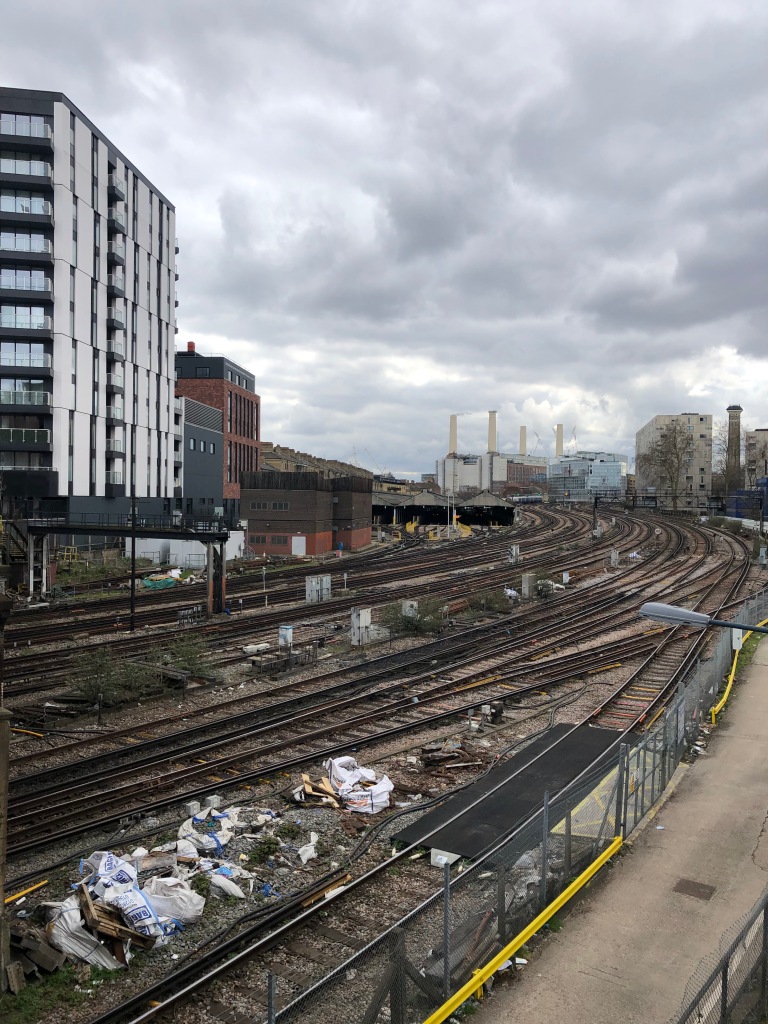
This picture is taken just to the side of Ebury Bridge itself, with the actual bridge having walls well above head height, presumably to prevent suicide attempts. Obviously, this is very important! However, the trainspotter/umarell in me wishes that there was a way to enjoy the view from the bridge, and starts to daydream about windows in the wall, accompanied by an AR (augmented reality) overlay which would highlight individual trains and show their destinations. No one will ever do this. But I enjoyed imagining it 🙂
I decide to cross Ebury Bridge, as I know that if I try and keep the line on my right, there will be very little to see of it from here until Victoria. So, I turn down Warwick Way, and immediately drop into the (seemingly) council block estate here, which backs directly onto the railway.
There is a small basketball court which makes use of the high railway wall as one of its boundaries, but perhaps more intriguing is the ‘Buckland House Wildlife Garden’

Assured of a ‘free visit’, I make my way to the back of the block, to find a ramshackle though clearly much loved triangle of soil backing onto the railway — scruffy and overgrown but with obvious signs of care, I suspect that it is a passion project of this one flat owner on a piece of scrap, unclaimed ground in the corner outside their door.
I am always heartwarmed by any efforts to reclaim and transform these kinds of spaces, and I like the window sign making something obviously very unofficial feel like something vaguely official.
The nature of the railways is that they cut through cities via (hopefully) the most direct routes possible, and development either springs up around them, or is bulldozed for them to pass through. This inevitably leaves lots of strange little chunks of land which, while technically owned, aren’t neccesarily that useful, and are ripe for the claiming by anyone with enough imagination and motivation.
Much of the walk so far has focussed on official uses of the actual railway infrstructure (like arches), but I am also interested in more unofficial uses of other spaces created as a result of the intersection of the trainlines and the city around them. These are often gardens! And this is a joy! But what else could they be?
Briefly getting lost by an annoying dead end, I eventually make it up onto Hugh Street, with little to report other than this intriguing shed/cupboard (with green doors), which appears to sit underneath the railway lines, and presumably belongs to one of the nearby houses.

I briefly pop up onto Elizabeth Bridge (another high-sided brick walled bridge over the tracks) to see whether I can walk along Bulleid Way, which, from maps, appears to be the route closest to the tracks, but on inspection is actually an enclosed delivery road leading into the station, closed to foot traffic. Instead I head back down, continuing along Hugh Street, and then turning left to enter the station ‘the back way’.

I feel like, over the course of my entire life, I must have travelled through Victoria Station well over 1,000 times, and yet from this angle it appears totally unfamiliar. I look out over this slightly bleak expanse and sigh with resigned acceptance… Well, I guess the car hire companies need a space to park their cars, and I guess staff need somewhere to park. But, before I enter, I pause and look back… And imagine this big open space a-buzz with market stalls — fresh food sizzling, crowds buzzing through, lingering in pop up dining areas… Or maybe it’s an antiques and clothing fair? The faded smell of mothballs drifting up from tables laden with old clothes as merchants holler and yell, and sequined vintage dresses rustle in the wind, as music plays from a DJ somewhere in the midst… I guess I’m daydreaming of something which it’s been a long time since I’ve experienced anywhere, and I’m daydreaming it into a space like this, because why SHOULDN’T it be? Sure, we’re not as bad as America, but we give up a lot of space in our cities for cars, and yo, it SUCKS.

I enter the station into ‘Victoria Place’, the shopping mall which adjoins the station. I am reminded of what I recently learned about Japan’s metro networks — in some cities there are vast underground networks of shopping malls around and running between metro stations there — the combination of commerce and transit may at times feel like an uneasy one, but actually in my book a big part of normalising and encouraging public transit is by making stations desirable places to be. Now sure — this mall ain’t that, with its small, dated, and entirely un-unique selection of shops, but it’s something in the right direction — and I remember, when visiting as a child from rural North Wales, my mother would joke that you could come to London and you ‘didn’t even need to leave the station to get all your fancy shopping done!’
And so, down we go, onto the main concourse.

What a strange place these big stations are to be just now. Normally this concourse would be packed with travellers rushing to and fro, but, at present, most people are still abiding by lockdown rules (I guess in the name of this research project I technically am *not*, but of course I remained masked at all times, and haven’t actually left my house to go anywhere else in well over two weeks, so…. I hope it’s an okay choice to be here.)
Ahead of you in this picture, you can see a green strip — this is a strange sort of texile mural which was installed around the time lockdown first begun last March. It was part of a range of efforts which seem to have been put in to make the station feel a bit more luxury, including a very lavish removation of the public toilets (like, incomprehensibly lavish, for a train station).

However at the moment, the station felt eerily closer to my experience in US stations. There are few people around, and those who are here are only here because they have no choice. There are a lot more homeless people (most people sat on those benches under the green mural appear to be homeless), however perhaps there are the same numbers there always have been, they’re just more apparent than normal in absence of the usual hustle and bustle.
It is crucial that we restore faith and trust in public transit post-pandemic, and in an era where many more people may find themselves working from home, how will we encourage re-uptake of an increasingly undesirable network, in a new era of germ-phobia and homebodies? Building a sense of place and desirability in stations will be one important part of that, and Victoria station seems as well placed as any to capitalise on this. Perhaps the traffic will come back on its own, but I think any nudges that can be made to people’s behaviour in terms of stations as desirable places to be, will be crucial.
Anyway, in order to mop up a couple of gaps in my knowledge, I hop on an (entirely empty) train for the four minute ride back to Battersea Park Station.
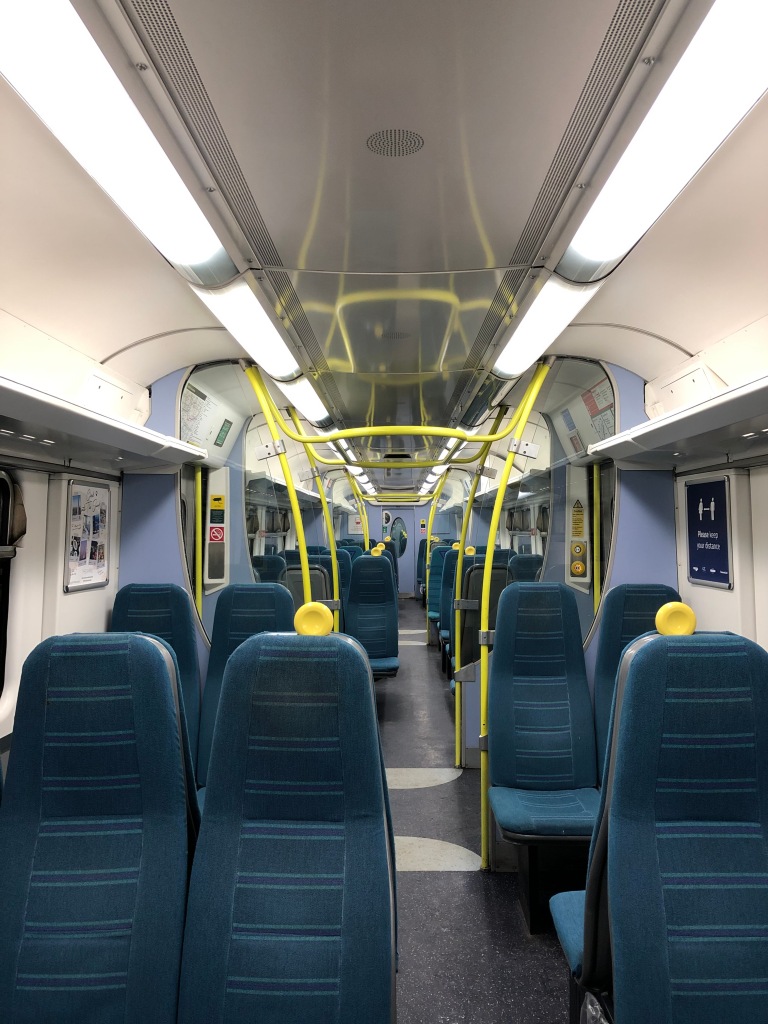
On the way home, the main previously inaccesible area which I get to see is Battersea Dogs and Cats Home, and frankly I can’t think of many better uses for one of those aforementioned strangely shaped chunks of spare land created as the railway carve their way through the city. (I just hope those sweet dog and cat pals don’t find the noise of the trains too scary!)
And immediately after this, we pull into Battersea Park Station.
I pause on platforms 2 and 3 where I get out, to look over at the long-disused platform 1.

The dusty platform has been out of use for a number of years, and sits there with, to me, so much potential. What could this space be? It can be acessed both from inside the station and from (I think) its own stairs at the back, as mentioned towards the start of this blog. Were I given unlimited funds and permission to do as I please, I would glass-pane over the side adjacent to the track and turn the platform into a cosy vegan cafe where patrons could sit and relax for as long as they wanted, and watch the trains thunder by.
Or maybe it’s a performance space, where, for the price of a train ticket, you could stand where I stand now and watch a performance play out. They do say ‘tread the boards’ in theatre, well, there are some boards right here, and what a joy it would be to see them pressed into a different kind of service.
Daydreaming about those possibilities, I head out through the (quite charming) main hall, getting briefly grumpy about the perpetually closed public toilet (public toilets are a crucial service, and I believe train stations can and should be an important part of this provision, both for passengers and non-passengers).

But overall, I am affectionate towards this station, and its potential-filled spaces, and I look forwards to travelling to and from here well into the future, and to finding new surprises all along my route, I hope.






